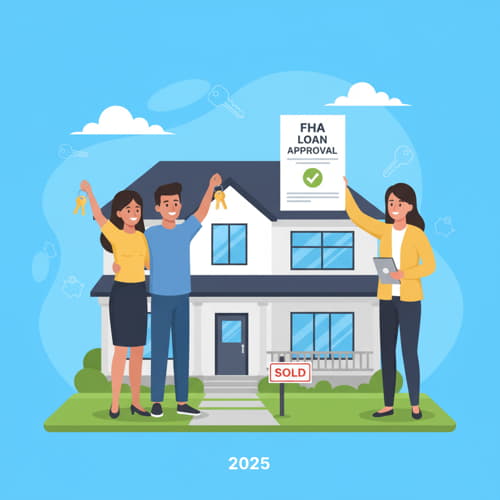FHA Loan Requirements 2025: Everything You Need to Know
FHA Loan Requirements 2025: Everything You Need to Know – Securing Your Home in 2026

Introduction: The Key to Homeownership (US Focus: 2025 & Planning for 2026)
For many first-time US homebuyers, a down payment is the biggest obstacle. The Federal Housing Administration (FHA) Loan solves this problem. This loan is government-insured. The FHA does not lend money directly. It insures the loan. This insurance protects the lender if the borrower defaults. The FHA Loan’s primary appeal is its lenient qualification criteria. This makes homeownership accessible to borrowers with lower credit scores and limited savings.
In 2025, FHA loans remain a critical entry point to the housing market. They require a much lower down payment than conventional loans. Looking ahead to 2026, experts predict FHA loans will play an even bigger role in affordability. This guide details the essential FHA loan requirements for 2025. It clarifies the credit and financial standards. It also offers a strategic outlook for successful FHA borrowing in the 2026 market.
## FHA Loan Defined: Lower Barriers to Entry
The FHA loan is a powerful tool for buyers who cannot meet the strict requirements of conventional financing.
| Feature | FHA Loan | Conventional Loan (Standard) |
| Minimum Down Payment | 3.5% | Often 5% – 20% |
| Minimum FICO Score | 580 (for 3.5% down) | Typically 620 – 640+ |
| Mortgage Insurance (MIP) | Required for the life of the loan (or 11 years with 10%+ equity) | Can be canceled once 20% equity is reached |
| Seller Concessions | Up to 6% allowed | Usually limited to 3% – 6% |
Key Takeaway: The FHA helps borrowers with weaker credit profiles. However, it requires mandatory mortgage insurance, which increases the total monthly cost.
## Core FHA Loan Requirements for 2025
Borrowers must satisfy four main requirements for FHA loan approval in 2025.
1. FICO Credit Score Standard
The FHA offers two main tiers based on your credit score:
- 580 FICO Score or Higher: You qualify for the maximum financing. This means only a 3.5% minimum down payment.
- 500 to 579 FICO Score: You may qualify, but you must make a 10% minimum down payment. Scores below 500 usually disqualify you.
2. Down Payment and Funding
You must provide a minimum down payment of 3.5% of the purchase price. The FHA is flexible about the source of these funds. They allow down payment gifts from family members, employers, or approved non-profit organizations. This makes FHA loans very popular with first-time buyers.
3. Debt-to-Income (DTI) Ratios
Lenders measure your DTI ratio. This ratio shows your ability to manage monthly payments. Lenders look at two ratios:
- Front-End Ratio: This covers the new house payment (PITI) only. The FHA generally wants this below 31%.
- Back-End Ratio: This includes the new house payment plus all other monthly debts (car loans, credit cards, etc.). The FHA prefers this ratio to remain below 43%. Lenders sometimes approve a ratio up to 50% for borrowers with excellent compensating factors.
4. Property Requirements (The Home Itself)
The FHA requires an appraisal. The home must meet FHA minimum property standards (MPS). MPS ensures the property is safe, sound, and secure.
- The home must be the borrower’s primary residence.
- The property must be a 1-4 unit dwelling.
- The appraisal ensures the home has no major health or safety defects.
## The Hidden Cost: Mortgage Insurance Premium (MIP)
MIP is the FHA loan’s biggest drawback. The FHA charges two separate fees:
- Upfront MIP (UFMIP): Lenders charge this fee at closing. It equals 1.75% of the loan amount. Borrowers usually finance this into the loan principal.
- Annual MIP: Lenders charge this fee yearly. It is divided into 12 monthly payments. The rate is typically 0.55% to 0.75% of the loan balance.
The Catch: Unlike conventional loan insurance (PMI), which cancels automatically at 20% equity, the FHA annual MIP often remains for the entire life of the loan. It only cancels if you made a down payment of 10% or more. This makes refinancing later a common strategy.
## Strategy for 2026: Preparing Your FHA Application
The housing market of 2026 will demand preparation. Follow this strategy in 2025 to secure the best FHA terms:
1. Boost Your Credit Score
- 2025 Action: Aim to get your FICO score above 620. This moves you out of the high-risk tier. A higher score secures the minimum 3.5% down payment. It also makes your application more attractive to lenders. Focus on paying down credit card balances.
2. Clean Up Your DTI
- 2025 Action: Pay off small, high-interest debts, like personal loans or credit cards. Lenders use the minimum required payment in their DTI calculation. Reducing these minimum payments directly lowers your DTI ratio.
- 2026 Benefit: A lower DTI ratio gives you more borrowing power in a tight 2026 market.
3. Start Savings Now for the 2026 Market
- 2025 Action: Save beyond the 3.5% down payment. Save enough to cover closing costs (often 2%-5% of the loan amount).
- 2026 Benefit: Having cash ready strengthens your offer. It allows you to enter a competitive market with confidence. It reduces reliance on seller concessions.
## Final Word: FHA Loans Open Doors
The FHA Loan in 2025 provides an accessible route to homeownership. It particularly helps those with modest savings or challenging credit histories. Therefore, borrowers must understand the commitment to MIP. They must also meet the necessary credit and DTI standards. By preparing diligently in 2025, first-time homebuyers can successfully navigate the requirements. They secure their low-down-payment FHA loan. They build wealth and achieve the dream of homeownership in 2026.
Related Posts

First-Time Home Buyer Loan Programs in 2025: What You Need to Know

How to Apply for a Home Loan Successfully
